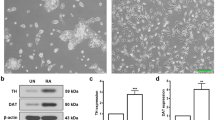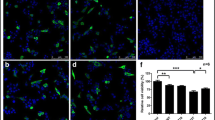Abstract
Accumulation of prion protein (PrPc) into a protease-resistant form (PrPsc) in the brains of humans and animals affects the central nervous system. PrPsc occurs only in mammals with transmissible prion diseases. Prion protein refers to either the infectious pathogen itself or the main component of the pathogen. Recent studies suggest that autophagy is one of the major functions that keep cells alive and which has a protective effect against neurodegeneration. In this study, we investigated whether the anti-hypertensive drug, captopril, could attenuate prion peptide PrP (106–126)-induced calcium alteration-mediated neurotoxicity. Treatment with captopril increased both LC3-II (microtubule-associated protein 1A/1B-light chain 3-II) and p62 protein levels, indicating autophagy flux inhibition. Electron microscopy confirmed the occurrence of autophagic flux inhibition in neuronal cells treated with captopril. Captopril attenuated PrP (106–126)-induced neuronal cell death via AMPK activation and autophagy inhibition. Compound C suppressed AMPK activation as well as the neuroprotective effects of captopril. Thus, these data showed that an anti-hypertensive drug has a protective effect against prion-mediated neuronal cell death via autophagy inhibition and AMPK activation, and also suggest that anti-hypertensive drugs may be effective therapeutic agents against neurodegenerative disorders, including prion diseases.






Similar content being viewed by others
References
Costanzo M, Zurzolo C (2013) The cell biology of prion-like spread of protein aggregates: mechanisms and implication in neurodegeneration. Biochem J 452(1):1–17. https://doi.org/10.1042/BJ20121898
Oesch B, Westaway D, Walchli M, McKinley MP, Kent SB, Aebersold R, Barry RA, Tempst P et al (1985) A cellular gene encodes scrapie PrP 27-30 protein. Cell 40(4):735–746
Aguzzi A, Weissmann C (1997) Prion research: the next frontiers. Nature 389(6653):795–798. https://doi.org/10.1038/39758
Aguzzi A (2008) Staining, straining and restraining prions. Nat Neurosci 11(11):1239–1240. https://doi.org/10.1038/nn1108-1239
Sarnataro D, Pepe A, Zurzolo C (2017) Chapter three - cell biology of prion protein. In: Legname G, Vanni S (eds) Progress in molecular biology and translational science, vol 150. Academic Press, pp 57–82. doi:https://doi.org/10.1016/bs.pmbts.2017.06.018
Boellaard JW, Kao M, Schlote W, Diringer H (1991) Neuronal autophagy in experimental scrapie. Acta Neuropathol 82(3):225–228
Berridge MJ, Bootman MD, Lipp P (1998) Calcium--a life and death signal. Nature 395(6703):645–648. https://doi.org/10.1038/27094
Berridge MJ, Lipp P, Bootman MD (2000) Signal transduction. The calcium entry pas de deux. Science (New York, NY) 287(5458):1604–1605
Paschen W (2003) Mechanisms of neuronal cell death: diverse roles of calcium in the various subcellular compartments. Cell Calcium 34(4–5):305–310
Florio T, Thellung S, Amico C, Robello M, Salmona M, Bugiani O, Tagliavini F, Forloni G et al (1998) Prion protein fragment 106-126 induces apoptotic cell death and impairment of L-type voltage-sensitive calcium channel activity in the GH3 cell line. J Neurosci Res 54(3):341–352. https://doi.org/10.1002/(sici)1097-4547(19981101)54:3<341::aid-jnr5>3.0.co;2-g
Thellung S, Florio T, Villa V, Corsaro A, Arena S, Amico C, Robello M, Salmona M et al (2000) Apoptotic cell death and impairment of L-type voltage-sensitive calcium channel activity in rat cerebellar granule cells treated with the prion protein fragment 106-126. Neurobiol Dis 7(4):299–309. https://doi.org/10.1006/nbdi.2000.0301
Mizushima N (2007) Autophagy: process and function. Genes Dev 21(22):2861–2873. https://doi.org/10.1101/gad.1599207
Kroemer G, Levine B (2008) Autophagic cell death: the story of a misnomer. Nat Rev Mol Cell Biol 9(12):1004–1010. https://doi.org/10.1038/nrm2529
Klionsky DJ, Emr SD (2000) Autophagy as a regulated pathway of cellular degradation. Science (New York, NY) 290(5497):1717–1721
Inoki K, Zhu T, Guan KL (2003) TSC2 mediates cellular energy response to control cell growth and survival. Cell 115(5):577–590
Corton JM, Gillespie JG, Hardie DG (1994) Role of the AMP-activated protein kinase in the cellular stress response. Curr Biol 4(4):315–324
Ng CH, Guan MS, Koh C, Ouyang X, Yu F, Tan EK, O'Neill SP, Zhang X et al (2012) AMP kinase activation mitigates dopaminergic dysfunction and mitochondrial abnormalities in Drosophila models of Parkinson’s disease. J Neurosci 32(41):14311–14317. https://doi.org/10.1523/jneurosci.0499-12.2012
Hawley SA, Pan DA, Mustard KJ, Ross L, Bain J, Edelman AM, Frenguelli BG, Hardie DG (2005) Calmodulin-dependent protein kinase kinase-beta is an alternative upstream kinase for AMP-activated protein kinase. Cell Metab 2(1):9–19. https://doi.org/10.1016/j.cmet.2005.05.009
Shaw RJ, Bardeesy N, Manning BD, Lopez L, Kosmatka M, DePinho RA, Cantley LC (2004) The LKB1 tumor suppressor negatively regulates mTOR signaling. Cancer Cell 6(1):91–99. https://doi.org/10.1016/j.ccr.2004.06.007
Woods A, Dickerson K, Heath R, Hong SP, Momcilovic M, Johnstone SR, Carlson M, Carling D (2005) Ca2+/calmodulin-dependent protein kinase kinase-beta acts upstream of AMP-activated protein kinase in mammalian cells. Cell Metab 2(1):21–33. https://doi.org/10.1016/j.cmet.2005.06.005
Hoyer-Hansen M, Bastholm L, Szyniarowski P, Campanella M, Szabadkai G, Farkas T, Bianchi K, Fehrenbacher N et al (2007) Control of macroautophagy by calcium, calmodulin-dependent kinase kinase-beta, and Bcl-2. Mol Cell 25(2):193–205. https://doi.org/10.1016/j.molcel.2006.12.009
Godfraind T (2014) Calcium channel blockers in cardiovascular pharmacotherapy. J Cardiovasc Pharmacol Ther 19(6):501–515. https://doi.org/10.1177/1074248414530508
Meeting SFDRTA, Walker BC, Walker SR (1988) Trends and changes in drug research and development. Springer
Patlak M (2004) From viper’s venom to drug design: treating hypertension. FASEB J 18(3):421
Alvin Z, Laurence GG, Coleman BR, Zhao A, Hajj-Moussa M, Haddad GE (2011) Regulation of L-type inward calcium channel activity by captopril and angiotensin II via the phosphatidyl inositol 3-kinase pathway in cardiomyocytes from volume-overload hypertrophied rat hearts. Can J Physiol Pharmacol 89(3):206–215. https://doi.org/10.1139/y11-011
Tsien RY, Pozzan T, Rink TJ (1982) T-cell mitogens cause early changes in cytoplasmic free Ca2+ and membrane potential in lymphocytes. Nature 295(5844):68–71
Florio T, Grimaldi M, Scorziello A, Salmona M, Bugiani O, Tagliavini F, Forloni G, Schettini G (1996) Intracellular calcium rise through L-type calcium channels, as molecular mechanism for prion protein fragment 106-126-induced astroglial proliferation. Biochem Biophys Res Commun 228(2):397–405. https://doi.org/10.1006/bbrc.1996.1673
Herms JW, Madlung A, Brown DR, Kretzschmar HA (1997) Increase of intracellular free Ca2+ in microglia activated by prion protein fragment. Glia 21(2):253–257
Korotzer AR, Whittemore ER, Cotman CW (1995) Differential regulation by beta-amyloid peptides of intracellular free Ca2+ concentration in cultured rat microglia. Eur J Pharmacol 288(2):125–130
Silei V, Fabrizi C, Venturini G, Salmona M, Bugiani O, Tagliavini F, Lauro GM (1999) Activation of microglial cells by PrP and beta-amyloid fragments raises intracellular calcium through L-type voltage sensitive calcium channels. Brain Res 818(1):168–170
Rubinsztein DC, Cuervo AM, Ravikumar B, Sarkar S, Korolchuk V, Kaushik S, Klionsky DJ (2009) In search of an “autophagomometer”. Autophagy 5(5):585–589
Bjorkoy G, Lamark T, Brech A, Outzen H, Perander M, Overvatn A, Stenmark H, Johansen T (2005) p62/SQSTM1 forms protein aggregates degraded by autophagy and has a protective effect on huntingtin-induced cell death. J Cell Biol 171(4):603–614. https://doi.org/10.1083/jcb.200507002
Brouwer RM, Bolli P, Erné P, Conen D, Kiowski W, Bühler FR (1985) Antihypertensive treatment using calcium antagonists in combination with captopril rather than diuretics. J Cardiovasc Pharmacol 7(1):S88–S91
Asaad MM, Antonaccio MJ (1982) Vascular wall renin in spontaneously hypertensive rats. Potential relevance to hypertension maintenance and antihypertensive effect of captopril. Hypertension 4(4):487–493. https://doi.org/10.1161/01.hyp.4.4.487
Schoenberger JA, Testa M, Ross AD, Brennan WK, Bannon JA (1990) Efficacy, safety, and quality-of-life assessment of captopril antihypertensive therapy in clinical practice. Arch Intern Med 150(2):301–306. https://doi.org/10.1001/archinte.1990.00390140051011
AbdAlla S, Langer A, Fu X, Quitterer U (2013) ACE inhibition with captopril retards the development of signs of neurodegeneration in an animal model of Alzheimer’s disease. Int J Mol Sci 14(8):16917–16942. https://doi.org/10.3390/ijms140816917
Connell BJ, Khan BV, Rajagopal D, Saleh TM (2012) Novel neurovascular protective agents: effects of INV-155, INV-157, INV-159, and INV-161 versus lipoic acid and captopril in a rat stroke model. Cardiol Res Pract 2012:319230. https://doi.org/10.1155/2012/319230
Sengul G, Coskun S, Cakir M, Coban MK, Saruhan F, Hacimuftuoglu A (2011) Neuroprotective effect of ACE inhibitors in glutamate - induced neurotoxicity: rat neuron culture study. Turk Neurosurg 21(3):367–371. https://doi.org/10.5137/1019-5149.jtn.4313-11.0
Sonsalla PK, Coleman C, Wong LY, Harris SL, Richardson JR, Gadad BS, Li W, German DC (2013) The angiotensin converting enzyme inhibitor captopril protects nigrostriatal dopamine neurons in animal models of parkinsonism. Exp Neurol 250:376–383. https://doi.org/10.1016/j.expneurol.2013.10.014
Inoki K, Kim J, Guan KL (2012) AMPK and mTOR in cellular energy homeostasis and drug targets. Annu Rev Pharmacol Toxicol 52:381–400. https://doi.org/10.1146/annurev-pharmtox-010611-134537
Otomo C, Metlagel Z, Takaesu G, Otomo T (2013) Structure of the human ATG12~ATG5 conjugate required for LC3 lipidation in autophagy. Nat Struct Mol Biol 20(1):59–66. https://doi.org/10.1038/nsmb.2431
Yang YP, Liang ZQ, Gu ZL, Qin ZH (2005) Molecular mechanism and regulation of autophagy. Acta Pharmacol Sin 26(12):1421–1434. https://doi.org/10.1111/j.1745-7254.2005.00235.x
Levine B, Yuan J (2005) Autophagy in cell death: an innocent convict? J Clin Invest 115(10):2679–2688. https://doi.org/10.1172/jci26390
Moscat J, Diaz-Meco MT (2009) p62 at the crossroads of autophagy, apoptosis, and cancer. Cell 137(6):1001–1004. https://doi.org/10.1016/j.cell.2009.05.023
Mizushima N, Yoshimori T (2007) How to interpret LC3 immunoblotting. Autophagy 3(6):542–545
Bauvy C, Meijer AJ, Codogno P (2009) Assaying of autophagic protein degradation. Methods Enzymol 452:47–61. https://doi.org/10.1016/s0076-6879(08)03604-5
Yoon YH, Cho KS, Hwang JJ, Lee SJ, Choi JA, Koh JY (2010) Induction of lysosomal dilatation, arrested autophagy, and cell death by chloroquine in cultured ARPE-19 cells. Invest Ophthalmol Vis Sci 51(11):6030–6037. https://doi.org/10.1167/iovs.10-5278
Saiki S, Sasazawa Y, Imamichi Y, Kawajiri S, Fujimaki T, Tanida I, Kobayashi H, Sato F et al (2011) Caffeine induces apoptosis by enhancement of autophagy via PI3K/Akt/mTOR/p70S6K inhibition. Autophagy 7(2):176–187
Kumar D, Shankar S, Srivastava RK (2013) Rottlerin-induced autophagy leads to the apoptosis in breast cancer stem cells: molecular mechanisms. Mol Cancer 12(1):171. https://doi.org/10.1186/1476-4598-12-171
Arsikin K, Kravic-Stevovic T, Jovanovic M, Ristic B, Tovilovic G, Zogovic N, Bumbasirevic V, Trajkovic V et al (2012) Autophagy-dependent and -independent involvement of AMP-activated protein kinase in 6-hydroxydopamine toxicity to SH-SY5Y neuroblastoma cells. Biochim Biophys Acta 1822(11):1826–1836. https://doi.org/10.1016/j.bbadis.2012.08.006
Jeong JK, Moon MH, Bae BC, Lee YJ, Seol JW, Kang HS, Kim JS, Kang SJ et al (2012) Autophagy induced by resveratrol prevents human prion protein-mediated neurotoxicity. Neurosci Res 73(2):99–105. https://doi.org/10.1016/j.neures.2012.03.005
Lee JH, Jeong JK, Park SY (2014) Sulforaphane-induced autophagy flux prevents prion protein-mediated neurotoxicity through AMPK pathway. Neuroscience 278:31–39. https://doi.org/10.1016/j.neuroscience.2014.07.072
Uchiyama Y, Koike M, Shibata M (2008) Autophagic neuron death in neonatal brain ischemia/hypoxia. Autophagy 4(4):404–408
Shintani T, Klionsky DJ (2004) Autophagy in health and disease: a double-edged sword. Science (New York, NY) 306(5698):990–995. https://doi.org/10.1126/science.1099993
Deretic V, Saitoh T, Akira S (2013) Autophagy in infection, inflammation and immunity. Nat Rev Immunol 13(10):722–737. https://doi.org/10.1038/nri3532
Wong E, Cuervo AM (2010) Autophagy gone awry in neurodegenerative diseases. Nat Neurosci 13(7):805–811. https://doi.org/10.1038/nn.2575
Funding
This study was supported by the National Research Foundation of the Korea Grant (MISP) funded by the Korean Government (2016R1A2B2009293).
Author information
Authors and Affiliations
Contributions
J.H.M., J.K.J., J.W.S., and S.Y.P. designed, executed the study, analyzed data, and wrote the manuscript. J.H.M. and J.K.J performed the electron microscopy. All authors have read and approved the final manuscript.
Corresponding author
Ethics declarations
Ethical Approval
Ethical approval for the project was granted by the institutional review board of the Chonbuk National University.
Conflict of Interest
The authors declare that they have no conflicts of interest.
Rights and permissions
About this article
Cite this article
Moon, JH., Jeong, JK., Hong, JM. et al. Inhibition of Autophagy by Captopril Attenuates Prion Peptide-Mediated Neuronal Apoptosis via AMPK Activation. Mol Neurobiol 56, 4192–4202 (2019). https://doi.org/10.1007/s12035-018-1370-8
Received:
Accepted:
Published:
Issue Date:
DOI: https://doi.org/10.1007/s12035-018-1370-8




